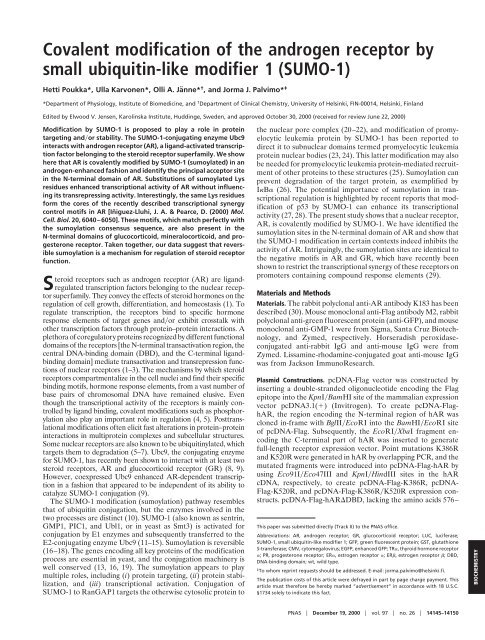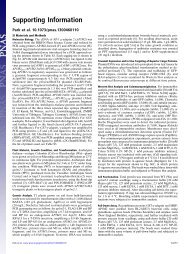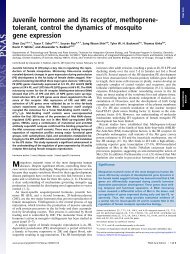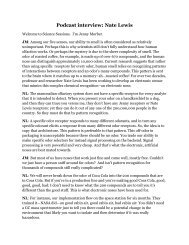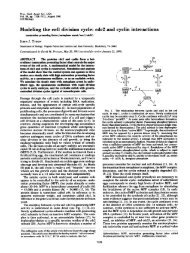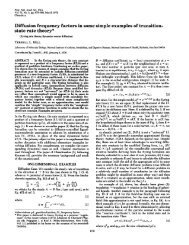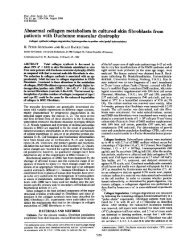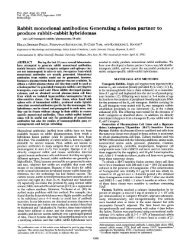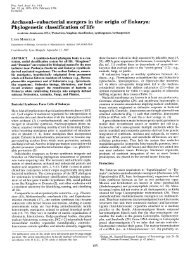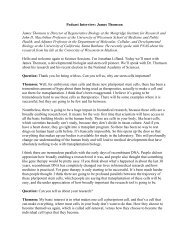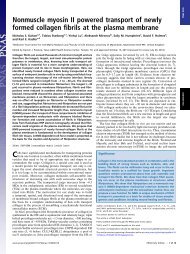SUMO-1 - Proceedings of the National Academy of Sciences
SUMO-1 - Proceedings of the National Academy of Sciences
SUMO-1 - Proceedings of the National Academy of Sciences
Create successful ePaper yourself
Turn your PDF publications into a flip-book with our unique Google optimized e-Paper software.
Covalent modification <strong>of</strong> <strong>the</strong> androgen receptor by<br />
small ubiquitin-like modifier 1 (<strong>SUMO</strong>-1)<br />
Hetti Poukka*, Ulla Karvonen*, Olli A. Jänne* † , and Jorma J. Palvimo* ‡<br />
*Department <strong>of</strong> Physiology, Institute <strong>of</strong> Biomedicine, and † Department <strong>of</strong> Clinical Chemistry, University <strong>of</strong> Helsinki, FIN-00014, Helsinki, Finland<br />
Edited by Elwood V. Jensen, Karolinska Institute, Huddinge, Sweden, and approved October 30, 2000 (received for review June 22, 2000)<br />
Modification by <strong>SUMO</strong>-1 is proposed to play a role in protein<br />
targeting and�or stability. The <strong>SUMO</strong>-1-conjugating enzyme Ubc9<br />
interacts with androgen receptor (AR), a ligand-activated transcription<br />
factor belonging to <strong>the</strong> steroid receptor superfamily. We show<br />
here that AR is covalently modified by <strong>SUMO</strong>-1 (sumoylated) in an<br />
androgen-enhanced fashion and identify <strong>the</strong> principal acceptor site<br />
in <strong>the</strong> N-terminal domain <strong>of</strong> AR. Substitutions <strong>of</strong> sumoylated Lys<br />
residues enhanced transcriptional activity <strong>of</strong> AR without influencing<br />
its transrepressing activity. Interestingly, <strong>the</strong> same Lys residues<br />
form <strong>the</strong> cores <strong>of</strong> <strong>the</strong> recently described transcriptional synergy<br />
control motifs in AR [Iñiguez-Lluhi, J. A. & Pearce, D. (2000) Mol.<br />
Cell. Biol. 20, 6040–6050]. These motifs, which match perfectly with<br />
<strong>the</strong> sumoylation consensus sequence, are also present in <strong>the</strong><br />
N-terminal domains <strong>of</strong> glucocorticoid, mineralocorticoid, and progesterone<br />
receptor. Taken toge<strong>the</strong>r, our data suggest that reversible<br />
sumoylation is a mechanism for regulation <strong>of</strong> steroid receptor<br />
function.<br />
Steroid receptors such as androgen receptor (AR) are ligandregulated<br />
transcription factors belonging to <strong>the</strong> nuclear receptor<br />
superfamily. They convey <strong>the</strong> effects <strong>of</strong> steroid hormones on <strong>the</strong><br />
regulation <strong>of</strong> cell growth, differentiation, and homeostasis (1). To<br />
regulate transcription, <strong>the</strong> receptors bind to specific hormone<br />
response elements <strong>of</strong> target genes and�or exhibit crosstalk with<br />
o<strong>the</strong>r transcription factors through protein–protein interactions. A<br />
plethora <strong>of</strong> coregulatory proteins recognized by different functional<br />
domains <strong>of</strong> <strong>the</strong> receptors [<strong>the</strong> N-terminal transactivation region, <strong>the</strong><br />
central DNA-binding domain (DBD), and <strong>the</strong> C-terminal ligandbinding<br />
domain] mediate transactivation and transrepression functions<br />
<strong>of</strong> nuclear receptors (1–3). The mechanisms by which steroid<br />
receptors compartmentalize in <strong>the</strong> cell nuclei and find <strong>the</strong>ir specific<br />
binding motifs, hormone response elements, from a vast number <strong>of</strong><br />
base pairs <strong>of</strong> chromosomal DNA have remained elusive. Even<br />
though <strong>the</strong> transcriptional activity <strong>of</strong> <strong>the</strong> receptors is mainly controlled<br />
by ligand binding, covalent modifications such as phosphorylation<br />
also play an important role in regulation (4, 5). Posttranslational<br />
modifications <strong>of</strong>ten elicit fast alterations in protein–protein<br />
interactions in multiprotein complexes and subcellular structures.<br />
Some nuclear receptors are also known to be ubiquitinylated, which<br />
targets <strong>the</strong>m to degradation (5–7). Ubc9, <strong>the</strong> conjugating enzyme<br />
for <strong>SUMO</strong>-1, has recently been shown to interact with at least two<br />
steroid receptors, AR and glucocorticoid receptor (GR) (8, 9).<br />
However, coexpressed Ubc9 enhanced AR-dependent transcription<br />
in a fashion that appeared to be independent <strong>of</strong> its ability to<br />
catalyze <strong>SUMO</strong>-1 conjugation (9).<br />
The <strong>SUMO</strong>-1 modification (sumoylation) pathway resembles<br />
that <strong>of</strong> ubiquitin conjugation, but <strong>the</strong> enzymes involved in <strong>the</strong><br />
two processes are distinct (10). <strong>SUMO</strong>-1 (also known as sentrin,<br />
GMP1, PIC1, and Ubl1, or in yeast as Smt3) is activated for<br />
conjugation by E1 enzymes and subsequently transferred to <strong>the</strong><br />
E2-conjugating enzyme Ubc9 (11–15). Sumoylation is reversible<br />
(16–18). The genes encoding all key proteins <strong>of</strong> <strong>the</strong> modification<br />
process are essential in yeast, and <strong>the</strong> conjugation machinery is<br />
well conserved (13, 16, 19). The sumoylation appears to play<br />
multiple roles, including (i) protein targeting, (ii) protein stabilization,<br />
and (iii) transcriptional activation. Conjugation <strong>of</strong><br />
<strong>SUMO</strong>-1 to RanGAP1 targets <strong>the</strong> o<strong>the</strong>rwise cytosolic protein to<br />
<strong>the</strong> nuclear pore complex (20–22), and modification <strong>of</strong> promyelocytic<br />
leukemia protein by <strong>SUMO</strong>-1 has been reported to<br />
direct it to subnuclear domains termed promyelocytic leukemia<br />
protein nuclear bodies (23, 24). This latter modification may also<br />
be needed for promyelocytic leukemia protein-mediated recruitment<br />
<strong>of</strong> o<strong>the</strong>r proteins to <strong>the</strong>se structures (25). Sumoylation can<br />
prevent degradation <strong>of</strong> <strong>the</strong> target protein, as exemplified by<br />
I�B� (26). The potential importance <strong>of</strong> sumoylation in transcriptional<br />
regulation is highlighted by recent reports that modification<br />
<strong>of</strong> p53 by <strong>SUMO</strong>-1 can enhance its transcriptional<br />
activity (27, 28). The present study shows that a nuclear receptor,<br />
AR, is covalently modified by <strong>SUMO</strong>-1. We have identified <strong>the</strong><br />
sumoylation sites in <strong>the</strong> N-terminal domain <strong>of</strong> AR and show that<br />
<strong>the</strong> <strong>SUMO</strong>-1 modification in certain contexts indeed inhibits <strong>the</strong><br />
activity <strong>of</strong> AR. Intriguingly, <strong>the</strong> sumoylation sites are identical to<br />
<strong>the</strong> negative motifs in AR and GR, which have recently been<br />
shown to restrict <strong>the</strong> transcriptional synergy <strong>of</strong> <strong>the</strong>se receptors on<br />
promoters containing compound response elements (29).<br />
Materials and Methods<br />
Materials. The rabbit polyclonal anti-AR antibody K183 has been<br />
described (30). Mouse monoclonal anti-Flag antibody M2, rabbit<br />
polyclonal anti-green fluorescent protein (anti-GFP), and mouse<br />
monoclonal anti-GMP-1 were from Sigma, Santa Cruz Biotechnology,<br />
and Zymed, respectively. Horseradish peroxidaseconjugated<br />
anti-rabbit IgG and anti-mouse IgG were from<br />
Zymed. Lissamine-rhodamine-conjugated goat anti-mouse IgG<br />
was from Jackson ImmunoResearch.<br />
Plasmid Constructions. pcDNA-Flag vector was constructed by<br />
inserting a double-stranded oligonucleotide encoding <strong>the</strong> Flag<br />
epitope into <strong>the</strong> KpnI�BamHI site <strong>of</strong> <strong>the</strong> mammalian expression<br />
vector pcDNA3.1(�) (Invitrogen). To create pcDNA-FlaghAR,<br />
<strong>the</strong> region encoding <strong>the</strong> N-terminal region <strong>of</strong> hAR was<br />
cloned in-frame with BglII�EcoRI into <strong>the</strong> BamHI�EcoRI site<br />
<strong>of</strong> pcDNA-Flag. Subsequently, <strong>the</strong> EcoRI�XbaI fragment encoding<br />
<strong>the</strong> C-terminal part <strong>of</strong> hAR was inserted to generate<br />
full-length receptor expression vector. Point mutations K386R<br />
and K520R were generated in hAR by overlapping PCR, and <strong>the</strong><br />
mutated fragments were introduced into pcDNA-Flag-hAR by<br />
using Eco91I�Eco47III and KpnI�HindIII sites in <strong>the</strong> hAR<br />
cDNA, respectively, to create pcDNA-Flag-K386R, pcDNA-<br />
Flag-K520R, and pcDNA-Flag-K386R�K520R expression constructs.<br />
pcDNA-Flag-hAR�DBD, lacking <strong>the</strong> amino acids 576–<br />
This paper was submitted directly (Track II) to <strong>the</strong> PNAS <strong>of</strong>fice.<br />
Abbreviations: AR, androgen receptor; GR, glucocorticoid receptor; LUC, luciferase;<br />
<strong>SUMO</strong>-1, small ubiquitin-like modifier 1; GFP, green fluorescent protein; GST, glutathione<br />
S-transferase; CMV, cytomegalovirus; EGFP, enhanced GFP; TR�, thyroid hormone receptor<br />
�; PR, progesterone receptor; ER�, estrogen receptor �; ER�, estrogen receptor �; DBD,<br />
DNA-binding domain; wt, wild type.<br />
‡ To whom reprint requests should be addressed. E-mail: jorma.palvimo@helsinki.fi.<br />
The publication costs <strong>of</strong> this article were defrayed in part by page charge payment. This<br />
article must <strong>the</strong>refore be hereby marked “advertisement” in accordance with 18 U.S.C.<br />
§1734 solely to indicate this fact.<br />
PNAS � December 19, 2000 � vol. 97 � no. 26 � 14145–14150<br />
BIOCHEMISTRY
657, was created by ligating <strong>the</strong> BglII�BamHI fragment from<br />
pEGFP-hAR�DBD to <strong>the</strong> BamHI site <strong>of</strong> pcDNA-Flag. Glutathione<br />
S-transferase (GST)-Ubc9 was constructed by inserting a<br />
PCR-amplified fragment encoding Ubc9 amino acids 2–158 into<br />
<strong>the</strong> BamHI�EcoRI site <strong>of</strong> pGEX-5X-1 (Amersham Pharmacia).<br />
pFlag-<strong>SUMO</strong>-1 was generated by inserting a PCR-amplified<br />
cDNA fragment encoding <strong>SUMO</strong>-1 amino acids 2–101 to <strong>the</strong><br />
HindIII�SalI site <strong>of</strong> pFlag-CMV-2. For <strong>the</strong> pEGFP-<strong>SUMO</strong>-1GA<br />
mutant, <strong>the</strong> PCR primer carried a point mutation that converts<br />
G97A. For expression <strong>of</strong> GST-<strong>SUMO</strong>-1 and enhanced GFP<br />
(EGFP)-<strong>SUMO</strong>-1, <strong>the</strong> <strong>SUMO</strong>-1 cDNA fragment was inserted<br />
into <strong>the</strong> BamHI�SalI site <strong>of</strong> pGEX-5X-1 or <strong>the</strong> BglII�SalI site <strong>of</strong><br />
pEGFP-C2 (CLONTECH). All PCR-amplified fragments were<br />
verified by sequencing. pARE2-TATA-LUC and pFLAG-Ubc9<br />
have been described (9, 31). pCMV-RelA and p�B6tk-LUC were<br />
from Patrick Baeuerle (Alberts-Ludwig Universität, Freiburg,<br />
Germany) (32). pGEM3Z-hGR was provided by Eckardt<br />
Treuter (Karolinska Institute, Huddinge, Sweden). pSG5-TR�1,<br />
pCMV5-hER�, and pCMV5-ER� vectors were gifts from Paul<br />
M. Yen (<strong>National</strong> Institutes <strong>of</strong> Health, Be<strong>the</strong>sda, MD), Benita<br />
Katzenellenbogen (University <strong>of</strong> Illinois, Urbana), and Jan-Åke<br />
Gustafsson (Karolinska Institute, Huddinge, Sweden), respectively.<br />
For pSG5-hER� and pSG5-hER�, <strong>the</strong> corresponding<br />
cDNAs from <strong>the</strong> pCMV5 constructs were inserted into pSG5.<br />
Cell Culture and Transfections. COS-1 and HeLa cells were obtained<br />
from <strong>the</strong> American Type Culture Collection and cultured<br />
in DMEM supplied with 10% FBS�25 units�ml penicillin and<br />
streptomycin. For HeLa cells, nonessential amino acids were also<br />
added. For immunoprecipitation experiments, 3.5 � 10 5 COS-1<br />
cells were seeded on 6-cm dishes 24 h before transfection. Two<br />
hours before transfection, <strong>the</strong> cells received fresh medium<br />
containing 10% charcoal-stripped FBS. By using <strong>the</strong> FuGene 6<br />
reagent (Roche Molecular Biochemicals), 0.5 �g <strong>of</strong> Flag-AR<br />
expression plasmids and 1.5 �g <strong>of</strong> GFP-<strong>SUMO</strong>-1 or EGFP-C2<br />
were transfected. Eight hours after transfection, <strong>the</strong> cells were<br />
supplied with 100 nM testosterone. For transactivation and<br />
transrepression assays, 5 � 10 4 COS-1 cells were seeded on<br />
12-well plates 24 h before transfection, and 4 h before transfection,<br />
<strong>the</strong> cells received fresh medium containing 10% charcoalstripped<br />
FBS. Reporter plasmid (150 ng), 50 ng <strong>of</strong> pCMV�<br />
(CLONTECH), and indicated amounts <strong>of</strong> AR expression constructs<br />
were transfected. Eighteen hours after transfection, <strong>the</strong><br />
cells received fresh medium containing 2% charcoal-stripped<br />
FBS and 100 nM testosterone or vehicle. After a 30-h culture, <strong>the</strong><br />
cells were harvested, and luciferase (LUC) and �-galactosidase<br />
activities were assayed as described (33, 34). pCMV-ARE2-LUC<br />
that contains <strong>the</strong> CMV-ARE2-TATA sequence (30) in KpnI�<br />
HindIII site <strong>of</strong> pGL3-Basic (Promega) was used for <strong>the</strong> promoter<br />
interference assay.<br />
<strong>SUMO</strong>-1 Conjugation in Vitro. GST-Ubc9 and GST-<strong>SUMO</strong>-1 were<br />
purified as described (35), eluted in TBS [137 mM NaCl�20 mM<br />
Tris�HCl (pH 7.6)]�10 mM reduced glutathione, and dialyzed<br />
overnight against TBS. <strong>SUMO</strong>-1-activating enzyme fraction was<br />
purified from HeLa cells essentially as described (15), except that<br />
Q Sepharose Fast Flow (Amersham Pharmacia) was used instead<br />
<strong>of</strong> Mono Q. For <strong>the</strong> conjugation assay, receptor constructs were<br />
translated in vitro by using <strong>the</strong> TNT rabbit reticulocyte system<br />
(Promega) in <strong>the</strong> presence <strong>of</strong> [ 35 S]Met. One microliter <strong>of</strong> <strong>the</strong> in vitro<br />
translation product was incubated with 5 �l <strong>of</strong> GST-<strong>SUMO</strong>-1, 4 �l<br />
<strong>of</strong> GST-Ubc9, and 2 �l<strong>of</strong>HeLacellfractionat30°Cfor1hin<strong>the</strong><br />
presence <strong>of</strong> 1 mM DTT�4 mM MgCl2�2 mM ATP. The reaction<br />
was terminated by adding 15 �l <strong>of</strong>2� SDS sample buffer. The<br />
samples were heated at 95°C for 5 min, resolved by electrophoresis<br />
on 7.5% polyacrylamide gels under denaturing conditions (SDS�<br />
PAGE), and visualized by fluorography.<br />
Fig. 1. AR is modified by <strong>SUMO</strong>-1. COS-1 cells grown on 6-cm dishes were<br />
transfected with vectors encoding Flag-tagged wt AR (wt) or AR lacking most <strong>of</strong><br />
<strong>the</strong> DBD and <strong>the</strong> hinge region (�DBD), and GFP-tagged <strong>SUMO</strong>-1 (<strong>SUMO</strong>) or<br />
<strong>SUMO</strong>-1GA (<strong>SUMO</strong>GA) expression vector. The cells received 100 nM testosterone<br />
(T) or vehicle 12 h before harvesting as indicated. Five percent <strong>of</strong> <strong>the</strong> cell extracts<br />
were immunoblotted with AR antibody (A), and <strong>the</strong> rest were subjected to<br />
immunoprecipitation with anti-Flag antibody. The immunoprecipitates were<br />
immunoblotted with anti-GFP antibody (B) or anti-<strong>SUMO</strong>-1 antibody (C). Arrowheads<br />
depict <strong>the</strong> slowly migrating sumoylated forms <strong>of</strong> AR.<br />
Immunoprecipitation and Immunoblotting. COS-1 cells were collected<br />
in PBS containing 20 mM N-ethylmaleimide, and cell<br />
extracts were prepared in modified RIPA buffer [50 mM<br />
Tris�HCl (pH 7.8)�150 mM NaCl�5 mM EDTA�15 mM<br />
MgCl2�1% NP-40�0.75% sodium deoxycholate�1 mMDTT],<br />
1:100 diluted protease inhibitor mixture (Sigma), and 20 mM<br />
N-ethylmaleimide. Immunoprecipitation with mouse monoclonal<br />
anti-Flag antibody was performed as described (31). Bound<br />
proteins were released in 2 � SDS sample buffer, resolved on<br />
7.5% SDS�PAGE, transferred onto Hybond enhanced chemiluminescence<br />
nitrocellulose membrane, and visualized by using<br />
<strong>the</strong> enhanced chemiluminescence detection reagents (Amersham<br />
Pharmacia) according to <strong>the</strong> manufacturer’s instructions.<br />
Results<br />
AR Is Modified by <strong>SUMO</strong>-1. Even though our previous results<br />
suggested that Ubc9 is capable <strong>of</strong> activating AR in a fashion that<br />
is independent <strong>of</strong> its sumoylation activity (9), it was still pertinent<br />
to examine <strong>the</strong> possibility that AR is covalently modified by<br />
<strong>SUMO</strong>-1. Flag-tagged human AR and <strong>SUMO</strong>-1 fused to GFP<br />
were transiently expressed in COS-1 cells, and cell extracts were<br />
prepared in <strong>the</strong> presence <strong>of</strong> N-ethylmaleimide, which is known<br />
to inhibit <strong>SUMO</strong>-1 deconjugation in vitro (16, 17). Immunoblotting<br />
<strong>of</strong> <strong>the</strong> cell extracts with a polyclonal anti-AR antibody<br />
showed three immunoreactive bands, a major �115-kDa band<br />
corresponding to <strong>the</strong> unmodified AR and two less intense more<br />
slowly migrating bands (�220 kDa) (Fig. 1A). To find out<br />
whe<strong>the</strong>r <strong>the</strong> slowly migrating bands represent AR modified by<br />
14146 � www.pnas.org Poukka et al.
GFP-tagged <strong>SUMO</strong>-1, immunoprecipitations were performed<br />
with Flag antibody. Both anti-GFP and anti-<strong>SUMO</strong>-1 antibody<br />
detected <strong>the</strong> two slowly migrating bands <strong>of</strong> higher molecular<br />
mass in <strong>the</strong> immunoprecipitate, whereas <strong>the</strong> 115-kDa unmodified<br />
AR band was not detected (Fig. 1 B and C). When <strong>the</strong><br />
GFP-tagged <strong>SUMO</strong>-1G97A mutant, which cannot be conjugated<br />
to target proteins, was used instead <strong>of</strong> wild-type (wt)<br />
<strong>SUMO</strong>-1 (36), no sumoylated AR forms were found (Fig. 1,<br />
lanes 4 and 5). These results indicate that <strong>the</strong> slowly migrating<br />
bands represent <strong>SUMO</strong>-1-modified forms <strong>of</strong> AR and suggest<br />
that <strong>the</strong>re are at least two sumoylation sites in <strong>the</strong> receptor.<br />
Ligand treatment <strong>of</strong> COS-1 cells enhanced <strong>the</strong> <strong>SUMO</strong>-1<br />
modification <strong>of</strong> AR (Fig. 1, lanes 2 vs. 3). This is not explained<br />
by differences in <strong>the</strong> amount <strong>of</strong> AR protein in <strong>the</strong> cells (Fig. 1A).<br />
Ra<strong>the</strong>r, <strong>the</strong> role <strong>of</strong> <strong>the</strong> ligand is likely to be coupled to <strong>the</strong><br />
transfer <strong>of</strong> holo-AR to <strong>the</strong> nucleus, where Ubc9 is primarily<br />
located (U.K., unpublished work). Only a relatively small proportion<br />
<strong>of</strong> apo-AR resides in COS-1 cell nuclei, and ligand<br />
treatment induces a complete transfer <strong>of</strong> holo-AR to nuclei<br />
(37–39). The AR mutant �DBD, lacking most <strong>of</strong> <strong>the</strong> DBD and<br />
<strong>the</strong> flanking hinge region (amino acid residues 576–657), which<br />
contains <strong>the</strong> bipartite nuclear localization signal (37, 38), is<br />
transferred poorly to <strong>the</strong> nucleus on ligand exposure and is<br />
totally unable to recognize DNA (39). The �DBD mutant was<br />
sumoylated less efficiently than wt AR, although <strong>the</strong> pattern <strong>of</strong><br />
modification remained unchanged (Fig. 1A, lanes 6 and 7).<br />
Because <strong>the</strong> missing AR region is known to contribute to <strong>the</strong><br />
AR–Ubc9 interaction (9), <strong>the</strong> less efficient attachment <strong>of</strong><br />
<strong>SUMO</strong>-1 to <strong>the</strong> �DBD mutant could also derive from its<br />
inefficient interaction with Ubc9.<br />
K386 Is <strong>the</strong> Major AR Site Modified by <strong>SUMO</strong>-1. Sumoylation <strong>of</strong><br />
proteins has been shown to occur at specific Lys residues,<br />
which are in most cases embedded in a consensus sequence<br />
(I�L�V)KXE, where X represents any amino acid (40, 41).<br />
Expression <strong>of</strong> a series <strong>of</strong> AR deletion mutants in COS-1 cells<br />
indicated that <strong>the</strong> two major slowly migrating forms <strong>of</strong> AR<br />
depended on <strong>the</strong> presence <strong>of</strong> <strong>the</strong> region encompassing amino<br />
acids 337–553 in <strong>the</strong> N-terminal region (data not shown). This<br />
region contains three Lys residues, K347, K386, and K520. Of<br />
<strong>the</strong>se three residues, <strong>the</strong> neighboring amino acid residues <strong>of</strong><br />
K386 (sequence IKLE) and K520 (sequence VKSE) match with<br />
<strong>the</strong> proposed <strong>SUMO</strong>-1 attachment consensus sequence. To test<br />
whe<strong>the</strong>r <strong>the</strong>se residues were indeed sumoylated, point mutations<br />
K386R and K520R were introduced into <strong>the</strong> Flag-tagged human<br />
AR. Immunoprecipitations <strong>of</strong> AR from extracts <strong>of</strong> COS-1 cells<br />
expressing <strong>the</strong>se constructs revealed that <strong>the</strong> K386R mutant <strong>of</strong><br />
AR is only weakly sumoylated (Fig. 2A, lane 4). Even though <strong>the</strong><br />
K520R mutation was not as deleterious to <strong>the</strong> modification as<br />
<strong>the</strong> K386R mutation, <strong>the</strong> K520R mutant <strong>of</strong> AR was never<strong>the</strong>less<br />
less efficiently sumoylated than wt AR (Fig. 2A, lane 5). When<br />
<strong>the</strong> point mutations were combined, no <strong>SUMO</strong>-1 was attached<br />
to <strong>the</strong> double mutant (Fig. 2A, lane 6). Likewise, in <strong>the</strong> absence<br />
<strong>of</strong> ectopically expressed <strong>SUMO</strong>-1, immunoblotting revealed<br />
slower migrating AR forms in cells expressing <strong>the</strong> wt AR but not<br />
in those expressing <strong>the</strong> compound mutant (Fig. 2B Upper).<br />
Immunoblotting <strong>of</strong> immunoprecipitated ARs with anti-<strong>SUMO</strong>-1<br />
antibody confirmed that <strong>the</strong> slower migrating AR forms indeed<br />
represented sumoylated AR (Fig. 2B Lower).<br />
Ubc9 Catalyzes Sumoylation <strong>of</strong> AR in Vitro. To study <strong>the</strong> catalytic<br />
role <strong>of</strong> Ubc9 in <strong>SUMO</strong>-1 modification <strong>of</strong> AR, 35 S-Met-labeled<br />
AR was incubated in <strong>the</strong> absence and presence <strong>of</strong> GST-Ubc9<br />
with GST-<strong>SUMO</strong>-1 and a HeLa cell fraction containing <strong>SUMO</strong>-<br />
1-activating enzyme (15). Ubc9 was required to produce <strong>the</strong> two<br />
slowly migrating forms <strong>of</strong> AR, corresponding to <strong>the</strong> AR<br />
<strong>SUMO</strong>-1 conjugates (Fig. 3A, lanes 1 and 2). This pattern is in<br />
line with <strong>the</strong> sumoylated AR forms detected with GFP-<strong>SUMO</strong>-1<br />
Fig. 2. K386 is <strong>the</strong> major sumoylation site in AR. COS-1 cells were transfected<br />
with pGFP-<strong>SUMO</strong>-1 or empty expression vector as indicated along with wt<br />
Flag-hAR, Flag-K386R, Flag-K520R, or Flag-K386R�K520R. The cells received<br />
100 nM testosterone 12 h before harvesting. Immunoblots and immunoprecipitations<br />
were performed as described in Fig. 1. (A Upper) Immunoblotting<br />
(WB) <strong>of</strong> cell extracts with anti-AR antibody (�-AR); (A Lower) immunoprecipitation<br />
with anti-Flag antibody and subsequent immunoblotting with anti-GFP<br />
antibody (�-GFP). (B Upper) COS-1 cells were transfected with expression<br />
vectors encoding wt AR or <strong>the</strong> K386R�K520R mutant, and <strong>the</strong> cell extracts<br />
were analyzed by immunoblotting with anti-AR antibody (�-AR); (B Lower)<br />
immunoprecipitation with anti-Flag antibody and subsequent immunoblotting<br />
with anti-<strong>SUMO</strong>-1 antibody (�-<strong>SUMO</strong>). Arrowheads depict <strong>the</strong> slowly<br />
migrating <strong>SUMO</strong>-1-conjugated ARs.<br />
by immunoblotting with anti-AR antibody (Fig. 2A Upper),<br />
because <strong>the</strong> size <strong>of</strong> GST-<strong>SUMO</strong>-1 is comparable to that <strong>of</strong><br />
GFP-<strong>SUMO</strong>-1. If <strong>the</strong> HeLa cell fraction or GST-<strong>SUMO</strong>-1 was<br />
omitted from <strong>the</strong> reaction, <strong>the</strong> slowly migrating AR bands were<br />
not detectable (data not shown). With <strong>the</strong> K386R mutant <strong>of</strong> AR,<br />
only a single very weak additional band was obtained in <strong>the</strong><br />
presence <strong>of</strong> Ubc9 (Fig. 3A, lane 3). The incubation <strong>of</strong> K520R<br />
mutant with Ubc9 yielded also only one additional major band,<br />
Fig. 3. Ubc9 catalyzes attachment <strong>of</strong> <strong>SUMO</strong>-1 to AR and GR in vitro. (A) In<br />
vitro-translated 35 S-Met-labeled wt and mutated AR constructs were incubated<br />
with GST-<strong>SUMO</strong>-1 and HeLa cell fraction containing <strong>SUMO</strong>-1-activating enzyme<br />
in <strong>the</strong> presence (�) or absence (�) <strong>of</strong> GST-Ubc9. The samples were resolved on<br />
7.5% SDS�PAGE and subjected to fluorography. Arrowheads depict <strong>the</strong> slowly<br />
migrating sumoylated forms <strong>of</strong> AR; Star, unmodified AR. (B) In vitro <strong>SUMO</strong>-1<br />
conjugation reactions with GR, ER�,ER�, and TR�. The reactions were performed<br />
in <strong>the</strong> presence (�) or absence (�) <strong>of</strong> GST-Ubc9 as described in A.<br />
Poukka et al. PNAS � December 19, 2000 � vol. 97 � no. 26 � 14147<br />
BIOCHEMISTRY
Table 1. Potential acceptor sites for <strong>SUMO</strong>-1 in selected nuclear<br />
receptors<br />
Receptor Residue Domain Sequence Swiss-Prot no.<br />
hAR K386 NT PHARIKLENPLDY P10275<br />
K520 NT SPTCVKSEMGPWD<br />
hGR K277 NT TLPQVKTEKEDFI P04150<br />
K293 NT TPGVIKQEKLGTV<br />
K703 LBD GKAIVKREGNSSQ<br />
hMR K89 NT LTSDIKTELESKE P08235<br />
K399 NT IVQYIKPEPDGAF<br />
K427 NT FSVPIKQESTKHS<br />
K494 NT FPVGIKQEPDDGS<br />
K953 LBD ESHALKVEFPAML<br />
hPR K388 NT PALKIKEEEEGAE P06401<br />
hER� P03372<br />
hER� Q92731<br />
hTR� K283 LBD GEMAVKREQLKNG P21205<br />
NT, amino-terminal region; LBD, ligand-binding domain.<br />
which was more intense than that observed with K386R (Fig. 3A,<br />
lane 4). Importantly, no sumoylated forms <strong>of</strong> AR were detected<br />
with <strong>the</strong> double mutant. Toge<strong>the</strong>r, <strong>the</strong>se results confirm that AR<br />
is modified by <strong>SUMO</strong>-1 on <strong>the</strong> amino acids K386 and K520, with<br />
<strong>the</strong> former one being <strong>the</strong> principal acceptor site.<br />
To examine whe<strong>the</strong>r some o<strong>the</strong>r nuclear receptors could serve<br />
as substrates for Ubc9, we looked for putative sumoylation sites<br />
in <strong>the</strong> sequences <strong>of</strong> steroid receptors and thyroid hormone<br />
receptor � (TR�). N-terminal regions <strong>of</strong> AR, GR, mineralocorticoid,<br />
and progesterone receptors and ligand-binding domains<br />
<strong>of</strong> GR, mineralocorticoid receptor, and TR� contain putative<br />
<strong>SUMO</strong>-1 attachment sites, whereas estrogen receptors � (ER�)<br />
and � (ER�) do not possess sequences matching with <strong>the</strong><br />
consensus sequence (Table 1). After incubation <strong>of</strong> in vitrotranslated<br />
GR, ER�, ER�, and TR� under <strong>the</strong> same conditions<br />
as those for AR, a slowly migrating form <strong>of</strong> GR appeared in <strong>the</strong><br />
presence but not in <strong>the</strong> absence <strong>of</strong> Ubc9 (Fig. 3B Left). In<br />
contrast, no Ubc9-dependent derivatives <strong>of</strong> ER�, ER�, orTR�<br />
were detected (Fig. 3B Right), suggesting that <strong>the</strong> latter receptors<br />
are not sumoylated. The high-molecular weight bands seen with<br />
ER� and ER� are not likely to represent <strong>SUMO</strong>-1 conjugates,<br />
because <strong>the</strong>ir appearance did not depend on Ubc9 that is <strong>the</strong> only<br />
<strong>SUMO</strong>-1-conjugating enzyme known thus far.<br />
Disruption <strong>of</strong> <strong>the</strong> <strong>SUMO</strong>-1 Acceptor Sites Enhances Transcriptional<br />
Activity <strong>of</strong> AR. Transactivation assays using minimal<br />
ARE2TATA-LUC reporter containing two hormone response<br />
Fig. 4. Substitutions <strong>of</strong> <strong>the</strong> sumoylation sites activate AR. (A) Transactivation by 10 ng <strong>of</strong> wt Flag-AR and <strong>the</strong> mutants K386R, K520R, and K386R�K520R was<br />
studied on minimal pARE2-TATA-LUC reporter (150 ng) in COS-1 cells. The cells received 100 nM testosterone (�T) or vehicle (�T) 18 h after transfection. LUC<br />
activities in cell extracts were adjusted to <strong>the</strong> transfection efficiency by using �-galactosidase activity. The activity <strong>of</strong> AR in <strong>the</strong> presence <strong>of</strong> testosterone is set<br />
as 100, and <strong>the</strong> means � SD from at least six independent experiments are shown. (B)AsinA, except that cells were transfected with 1–100 ng <strong>of</strong> AR expression<br />
plasmids as indicated. The amount <strong>of</strong> transfected DNA was balanced by <strong>the</strong> addition <strong>of</strong> empty expression vector. (Inset) Expression levels <strong>of</strong> wt AR and<br />
K386R�K520R mutant in an experiment corresponding to data shown in B. AR was immunoblotted with AR antibody from <strong>the</strong> same lysates (pooled from triplicate<br />
wells) that were used for reporter gene assays. (C) Effect <strong>of</strong> coexpressed Ubc9 on transactivation by AR and K386R�K520R. The conditions were as in A, except<br />
that indicated amounts <strong>of</strong> pFLAG-Ubc9 (in �g) were cotransfected and <strong>the</strong> total amount <strong>of</strong> DNA was balanced by adding empty pFLAG-CMV2. Black bars depict<br />
wt AR and gray ones K386R�K520R mutant.<br />
14148 � www.pnas.org Poukka et al.
elements were used to examine whe<strong>the</strong>r substitutions in <strong>the</strong><br />
<strong>SUMO</strong>-1 attachment sites <strong>of</strong> AR influence <strong>the</strong> transcriptional<br />
activity <strong>of</strong> <strong>the</strong> receptor. The K520R mutant that is modified by<br />
<strong>SUMO</strong>-1 almost as well as wt AR had transcriptional activity in<br />
COS-1 cells indistinguishable from that <strong>of</strong> wt AR (Fig. 4A). In<br />
contrast, K386R and K386R�K520R mutants, which were poor<br />
targets for <strong>SUMO</strong>-1 conjugation, had activities 1.9- and 2.4-fold<br />
higher than that <strong>of</strong> wt AR, respectively. More importantly, <strong>the</strong><br />
compound mutant was constantly 2.4- to 3.3-fold more active<br />
than <strong>the</strong> wt receptor over a wide range <strong>of</strong> expression plasmid<br />
amounts (1–100 ng�well) and testosterone concentrations (0.1–<br />
100 nM) (Fig. 4B and data not shown). The higher transcriptional<br />
activity <strong>of</strong> K386R�K520R mutant cannot be explained by<br />
receptor protein levels because, if anything, <strong>the</strong> expression level<br />
<strong>of</strong> <strong>the</strong> double mutant was lower than that <strong>of</strong> wt AR as assessed<br />
by immunoblotting (Fig. 4B Inset). In addition to COS-1 cells,<br />
K386R and K386R�K520R mutants were 2- and 2.4-fold more<br />
active than wt AR in HeLa cells (data not shown).<br />
We have previously shown that overexpression <strong>of</strong> Ubc9 can<br />
result in enhancement <strong>of</strong> AR-mediated transcription. As shown<br />
in Fig. 4C, ligand-dependent activity <strong>of</strong> wt AR was clearly<br />
enhanced (3.2-fold) when 100 ng�well <strong>of</strong> Ubc9 was coexpressed,<br />
whereas <strong>the</strong> compound mutant showed practically no response<br />
to Ubc9 (1.2-fold). However, K386R�K520R mutant was stimulated<br />
by a higher Ubc9 dose (300 ng�well), even though <strong>the</strong><br />
induction (1.9-fold) was clearly lower than that with wt receptor<br />
(5.1-fold). Thus, effects <strong>of</strong> Ubc9 overexpression on ARdependent<br />
transcription are complex and not merely a direct<br />
consequence <strong>of</strong> enhanced sumoylation <strong>of</strong> AR. This is in line with<br />
<strong>the</strong> finding that sumoylation-negative Ubc9 mutant can also<br />
stimulate AR-dependent transactivation (9). Overexpression <strong>of</strong><br />
Ubc9 may, in fact, stall <strong>the</strong> sumoylation machinery because o<strong>the</strong>r<br />
components <strong>of</strong> <strong>the</strong> conjugation system are likely to become<br />
limiting. This should lead to enhancement ra<strong>the</strong>r than inhibition<br />
<strong>of</strong> AR-dependent transcription.<br />
In contrast to transcriptional activation, <strong>the</strong> transrepressing<br />
function <strong>of</strong> AR was not influenced by substitution <strong>of</strong> <strong>SUMO</strong>-1<br />
acceptor sites, because both wt AR and <strong>the</strong> K386R�K520R<br />
mutant repressed a NF-�B�RelA-activated promoter to <strong>the</strong><br />
same extent (Fig. 5A). Fur<strong>the</strong>rmore, <strong>the</strong> effects <strong>of</strong> <strong>the</strong> point<br />
mutations on ligand binding and DNA binding by AR were<br />
investigated in intact cells. Consistent with <strong>the</strong> lower expression<br />
level <strong>of</strong> <strong>the</strong> compound mutant, cells transfected with <strong>the</strong> mutant<br />
construct showed �30% less androgen-binding sites than cells<br />
transfected wt AR, as assessed by whole cell-binding assays (data<br />
not shown). DNA-binding capacity <strong>of</strong> compound mutant, as<br />
examined by promoter interference assays using <strong>the</strong> same double<br />
hormone response elements as in ARE2TATA-LUC, was somewhat<br />
lower (10–20%) than that <strong>of</strong> wt AR (30) (Fig. 5B), which<br />
is in line with androgen-binding data.<br />
Discussion<br />
In <strong>the</strong> present study, we have shown that a ligand-activated<br />
transcription factor, AR, is covalently modified by <strong>SUMO</strong>-1 in<br />
intact cells and under cell-free conditions. Androgen promoted<br />
sumoylation in cells, probably by facilitating <strong>the</strong> nuclear transfer<br />
<strong>of</strong> cytoplasmic AR. The sumoylation sites <strong>of</strong> human AR are<br />
K386 and K520. The former appears to act as a master switch <strong>of</strong><br />
sumoylation, because <strong>the</strong> K386 mutant was modified only poorly,<br />
whereas <strong>the</strong> K520 mutation impaired <strong>the</strong> extent <strong>of</strong> <strong>SUMO</strong>-1<br />
conjugation much less. The overall cellular distribution <strong>of</strong> <strong>the</strong><br />
K386R�K520R mutant and its hormone-induced nuclear translocation<br />
were very similar to those <strong>of</strong> <strong>the</strong> wt AR (data not<br />
shown). Both sumoylation sites are fully conserved in mammalian<br />
AR sequences, and a site corresponding to human K386 is<br />
also present in <strong>the</strong> Xenopus AR.<br />
In addition to AR, several o<strong>the</strong>r, but not all, members <strong>of</strong> <strong>the</strong><br />
steroid receptor family contain potential (I�L�V)KXE attachment<br />
Fig. 5. Effect <strong>of</strong> K386R�K520R mutation on transrepressing activity <strong>of</strong> AR<br />
and DNA binding in intact cells. (A) Repression <strong>of</strong> RelA-dependent transactivation<br />
by wt AR and K386R�K520R mutant. COS-1 cells were transfected with<br />
p�B6tk-LUC (150 ng), pCMV-RelA (30 ng), and AR expression vectors (150 ng).<br />
The relative LUC activity in <strong>the</strong> absence <strong>of</strong> cotransfected AR is set as 100. Values<br />
are means � SD from six independent experiments. (B) Binding <strong>of</strong> <strong>the</strong> wt and<br />
mutant AR to androgen response elements in intact cells as determined by a<br />
promoter interference assay (30). COS-1 cells were transfected with pCMV-<br />
ARE2-LUC reporter (100 ng) and increasing amounts (10, 50, and 100 ng) <strong>of</strong> wt<br />
Flag-AR and K386R�K520R mutant expression vectors. The total amount <strong>of</strong><br />
DNA was kept constant by adding empty pcDNA3.1(�) when necessary.<br />
Reporter gene activity in <strong>the</strong> absence <strong>of</strong> AR expression vector is set as 100, and<br />
<strong>the</strong> means � SD from three independent experiments are shown. Black and<br />
gray bars depict wt AR and K386R�K520R mutant, respectively.<br />
sites for <strong>SUMO</strong>-1 (Table 1). In this study, we show that GR is<br />
modified by <strong>SUMO</strong>-1 in vitro under <strong>the</strong> same Ubc9-dependent<br />
conditions as those used for AR. Intriguingly, <strong>the</strong> sumoylated sites<br />
in AR and <strong>the</strong> two potential modification sites in <strong>the</strong> N-terminal<br />
domain <strong>of</strong> GR are identical with <strong>the</strong> protein motifs that have<br />
recently been demonstrated to restrict <strong>the</strong> transcriptional synergy <strong>of</strong><br />
<strong>the</strong> two receptors (29). In line with our data on AR, disruption <strong>of</strong><br />
<strong>the</strong>se sites by replacing <strong>the</strong> central <strong>SUMO</strong>-1 acceptor Lys with Arg<br />
led to enhancement <strong>of</strong> AR-dependent transcription on promoters<br />
with more than one hormone response elements (29). The synergy<br />
control motifs are identical with <strong>the</strong> sumoylation consensus sequence,<br />
and <strong>the</strong>y can be found in negative regulatory regions <strong>of</strong><br />
many, o<strong>the</strong>rwise unrelated, transcription factors (29), suggesting<br />
that sumoylation can act as a general mechanism controlling <strong>the</strong>ir<br />
activities.<br />
In contrast to AR, sumoylation <strong>of</strong> p53 has recently been<br />
implicated in <strong>the</strong> activation <strong>of</strong> p53-dependent transcription (27,<br />
28). However, similar to AR, <strong>the</strong> basal transcriptional activity <strong>of</strong><br />
<strong>the</strong> sumoylation-defective p53 mutant was ei<strong>the</strong>r equal to or<br />
higher than that <strong>of</strong> wt p53, depending on <strong>the</strong> promoter studied.<br />
In <strong>the</strong> case <strong>of</strong> AR, <strong>the</strong> extent to which <strong>SUMO</strong>-1 acceptor sites<br />
were mutated correlated with increased transcriptional activity,<br />
indicating that sumoylation can, in fact, attenuate AR function.<br />
This is in agreement with a recent report showing that c-Jun is<br />
negatively regulated by sumoylation (42). The result that <strong>the</strong><br />
K386R�K520R mutant was coactivated by GR-interacting protein<br />
1 (GRIP1) in a fashion similar to wt AR (data not shown)<br />
is in keeping with <strong>the</strong> fact that <strong>the</strong> sumoylation sites do not<br />
overlap with <strong>the</strong> core transactivation domain <strong>of</strong> AR (43). The<br />
sumoylation sites localize to <strong>the</strong> N-terminal region <strong>of</strong> AR that is<br />
involved in interactions with <strong>the</strong> hormone-bound ligand-binding<br />
domain, and <strong>the</strong>refore, attachment <strong>of</strong> bulky ‘‘side chains’’ to this<br />
region is likely to perturb with <strong>the</strong> ability <strong>of</strong> AR to make<br />
intramolecular contacts (33). NF-�B-transrepressing activity <strong>of</strong><br />
AR (44) is not influenced by point mutations substituting <strong>the</strong><br />
Poukka et al. PNAS � December 19, 2000 � vol. 97 � no. 26 � 14149<br />
BIOCHEMISTRY
sumoylation sites. This suggests that sumoylation modulates<br />
interactions specific for <strong>the</strong> transactivation process. These results<br />
are in agreement with those obtained by using <strong>the</strong> synergy<br />
control motif-disrupted GR (29).<br />
Only a relatively small proportion <strong>of</strong> total AR can be detected<br />
as conjugated to <strong>SUMO</strong>-1 in transfected cells. This is not<br />
completely in line with data from transactivation experiments, in<br />
which substitutions <strong>of</strong> <strong>the</strong> AR residues responsible for sumoylation<br />
clearly enhanced <strong>the</strong> transcriptional activity <strong>of</strong> AR. These<br />
results suggest that <strong>the</strong> modification is transient and that <strong>the</strong>re<br />
is a dynamic equilibrium between <strong>SUMO</strong>-1-conjugated and<br />
unconjugated receptor forms. Thus, sumoylation is likely to<br />
represent a mechanism for a rapid and reversible attenuation <strong>of</strong><br />
AR function in distinct promoter contexts.<br />
In conclusion, <strong>the</strong> importance <strong>of</strong> <strong>SUMO</strong>-1 modifications in<br />
1. Beato, M., Herrlich, P. & Schütz, G. (1995) Cell 83, 851–857.<br />
2. McKenna, N. J., Lanz, R. B. & O’Malley, B. W. (1999) Endocr. Rev. 20,<br />
321–344.<br />
3. Freedman, L. P. (1999) Cell 97, 5–8.<br />
4. Weigel, N. L. & Zhang, Y. (1997) J. Mol. Med. 76, 469–479.<br />
5. Lange, C. A., Shen, T. & Horwitz, K. B. (2000) Proc. Natl. Acad. Sci. USA 97,<br />
1032–1037.<br />
6. Li, X.-Y., Boudjelal, M., Xiao, J.-H., Peng, Z.-H., Asuru, A., Kang, S., Fisher,<br />
G. J. & Voorhees, J. J. (1999) Mol. Endocrinol. 13, 1686–1699.<br />
7. Nawaz, Z., Lonard, D. M., Dennis, A. P., Smith, C. L. & O’Malley, B. W. (1999)<br />
Proc. Natl. Acad. Sci. USA 96, 1858–1862.<br />
8. Göttlicher, M., Heck, S., Doucas, V., Wade, E., Kullmann, M., Cato, A. C. B.,<br />
Evans, R. M. & Herrlich, P. (1996) Steroids 61, 257–262.<br />
9. Poukka, H., Aarnisalo, P., Karvonen, U., Palvimo, J. J. & Jänne, O. A. (1999)<br />
J. Biol. Chem. 274, 19441–19446.<br />
10. Melchior, F. (2000) Annu. Rev. Dev. Biol. 16, 591–626.<br />
11. Desterro, J. M. P., Rodriguez, M. S., Kemp, G. D. & Hay, R. T. (1999) J. Biol.<br />
Chem. 274, 10618–10624.<br />
12. Okuma, T., Honda, R., Ichikawa, G., Tsumagari, N. & Yasuda, H. (1999)<br />
Biochem. Biophys. Res. Commun. 254, 693–698.<br />
13. Johnson, E. S., Schwienhorst, I., Dohmen, R. J. & Blobel, G. (1997) EMBO J.<br />
16, 5509–5519.<br />
14. Johnson, E. S. & Blobel, G. (1997) J. Biol. Chem. 272, 26799–26802.<br />
15. Schwarz, S. E., Matuschewski, K., Liakopoulos, D., Scheffner, M. & Jentsch,<br />
S. (1998) Proc. Natl. Acad. Sci. USA 95, 560–564.<br />
16. Li, S.-J. & Hochstrasser, M. (1999) Nature (London) 398, 246–251.<br />
17. Suzuki, T., Ichiyama, A., Saitoh, H., Kawakami, T., Omata, M., Chung, C. H.,<br />
Kimura, M., Shimbara, N. & Tanaka, K. (1999) J. Biol. Chem. 274, 31131–<br />
31134.<br />
18. Gong, L., Millas, S., Maul, G. G. & Yeh, E. T. H. (2000) J. Biol. Chem. 275,<br />
3355–3359.<br />
19. Seufert, W., Futcher, B. & Jentsch, S. (1995) Nature (London) 373, 78–81.<br />
20. Mahajan, R., Delphin, C., Guan, T., Gerace, L. & Melchior, F. (1997) Cell 88,<br />
97–107.<br />
21. Mahajan, R., Gerace, L. & Melchior, F. (1998) J. Cell Biol. 140, 259–270.<br />
22. Matunis, M. J., Wu, J. & Blobel, G. (1998) J. Cell Biol. 140, 499–509.<br />
23. Müller, S., Matunis, M. J. & Dejean, A. (1998) EMBO J. 17, 61–70.<br />
transcriptional regulation is emerging. Current results demonstrate<br />
<strong>the</strong> existence <strong>of</strong> a new modulatory system to restrict<br />
steroid receptor activity. Fur<strong>the</strong>r characterization <strong>of</strong> sumoylation<br />
<strong>of</strong> AR has implications in various physiological processes<br />
and in pathological states, including prostate cancer.<br />
We thank Kati Saastamoinen, Leena Pietilä, and Seija Mäki for excellent<br />
technical assistance; and Jan-Åke Gustafsson, Benita Katzenellenbogen,<br />
Eckardt Treuter, Paul M. Yen, and Patrick Baeuerle for plasmids. This<br />
work was supported by grants from <strong>the</strong> Medical Research Council<br />
(<strong>Academy</strong> <strong>of</strong> Finland), <strong>the</strong> Finnish Foundation for Cancer Research, <strong>the</strong><br />
Sigrid Jusélius Foundation, Biocentrum Helsinki, <strong>the</strong> Helsinki University<br />
Central Hospital, CaP CURE, <strong>the</strong> Finnish Medical Society Duodecim,<br />
<strong>the</strong> Finnish Cultural Foundation, and <strong>the</strong> Research and Science<br />
Foundation <strong>of</strong> Farmos.<br />
24. Duprez, E., Saurin, A. J., Desterro, J. M., Lallemand-Breitenbach, V., Howe,<br />
K., Boddy, M. N., Solomon, E., de Thé, H., Hay, R. T. & Freemont, P. S. (1999)<br />
J. Cell Sci. 112, 381–393.<br />
25. Ishov, A. M., Sotnikov, A. G., Vladimirova, O. V., Neff, N., Kamitani, T., Yeh,<br />
E. T. H., Strauss, J. F., III & Maul, G. G. (1999) J. Cell Biol. 147, 221–233.<br />
26. Desterro, J. M. P., Rodriguez, M. S. & Hay, R. T. (1998) Mol. Cell 2, 233–239.<br />
27. Gostissa, M., Hengstermann, A., Fogalm, V., Sandy, P., Schwarz, S. E.,<br />
Scheffner, M. & Del Sal, G. (1999) EMBO J. 18, 6462–6471.<br />
28. Rodriguez, M. S., Desterro, J. M. P., Lain, S., Midgley, C. A., Lane, D. P. &<br />
Hay, R. T. (1999) EMBO J. 18, 6455–6461.<br />
29. Iñiguez-Lluhi, J. A. & Pearce, D. (2000) Mol. Cell. Biol. 20, 6040–6050.<br />
30. Karvonen, U., Kallio, P. J., Jänne, O. A. & Palvimo, J. J. (1997) J. Biol. Chem.<br />
272, 15973–15979.<br />
31. Moilanen, A.-M., Poukka, H., Karvonen, U., Häkli, M., Jänne, O. A. &<br />
Palvimo, J. J. (1998) Mol. Cell. Biol. 18, 5128–5139.<br />
32. Schmitz, M. L. & Baeuerle, P. A. (1991) EMBO J. 10, 3805–3815.<br />
33. Ikonen, T., Palvimo, J. J. & Jänne, O. A. (1997) J. Biol. Chem. 272, 29821–<br />
29828.<br />
34. Rosenthal, N. (1987) Methods Enzymol. 152, 704–720.<br />
35. Poukka, H., Aarnisalo, P., Santti, H., Jänne, O. A. & Palvimo, J. J. (2000)<br />
J. Biol. Chem. 275, 571–579.<br />
36. Kamitani, T. M., Nguyen, H. P. & Yeh, E. T. H. (1997) J. Biol. Chem. 272,<br />
14001–14004.<br />
37. Jenster, G., Trapman, J. & Brinkmann, A. O. (1993) Biochem. J. 293, 761–768.<br />
38. Zhou, Z., Sar, M., Simental, J. A., Lane, M. V. & Wilson, E. M. (1994) J. Biol.<br />
Chem. 269, 13115–13123.<br />
39. Poukka, H., Karvonen, U., Yoshikawa, N., Tanaka, H., Palvimo J. J. & Jänne,<br />
O. A. (2000) J. Cell Sci. 113, 2991–3001.<br />
40. Sternsdorf, T., Jensen, K., Reich, B. & Will, H. (1999) J. Biol. Chem. 274,<br />
12555–12566.<br />
41. Johnson, E. S. & Blobel, G. (1999) J. Cell Biol. 147, 981–993.<br />
42. Müller, S., Berger, M., Lehembre, F., Seeler, J.-S., Haupt, Y. & Dejean, A.<br />
(2000) J. Biol. Chem. 275, 13321–13329.<br />
43. Jenster, G., van der Korput, H. A., Trapman, J. & Brinkmann, A. O. (1995)<br />
J. Biol. Chem. 270, 7341–7346.<br />
44. Palvimo, J. J., Reinikainen, P., Ikonen, T., Kallio, P. J., Moilanen, A. & Jänne,<br />
O. A. (1996) J. Biol. Chem. 271, 24151–24156.<br />
14150 � www.pnas.org Poukka et al.


